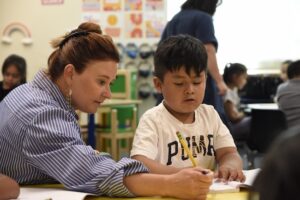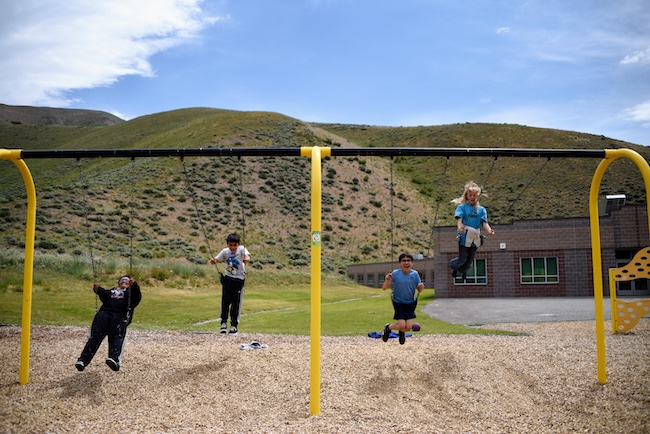Public Money, Private Partners Bring SummerBridge To Life
BY Mark Dee

It’s the middle of a Wednesday, and kids are catapulting off the swings outside Alturas Elementary. Inside, they’re lining up for sandwiches and filing along the narrow tables of the cafeteria. Mrs. Zimmerman’s class of rising first graders is counting into double digits—in a few minutes, learn “19” and pencil the figures in thick Ticonderoga.
In other words, it’s another day at the Blaine County School District’s busiest grade school. Except later, the temperature will tip towards 90 degrees. Up the road, the rodeo will pull into town, and Independence Day festivities will begin in earnest.
It’s July 2, the heart of summer, and class is in session.
For five weeks, that’s a standard day for the 289 local students and roughly 85 staff who make up the school district’s SummerBridge academic camp, a partnership between the public school system and slew of local nonprofits. The program is as close to a free year-round school as you’ll find in Idaho, with costs covered by local donors and, after voters passed a two-year supplemental levy last year, Blaine County taxpayers. In the view of Assistant Superintendent Adam Johnson, it has evolved into the “premier summer school in Idaho.”
“It’s what a lot of districts wish they could execute, we just have the infrastructure to make it happen,” Johnson said. “We tend to get really sandbox-y—this is nonprofit world, this is public education. To break that down, that’s been neat… Rather than compete, let’s focus on what we each do best and pour everything into this.”
Born in the wake of the COVID-19 pandemic, when federal money aimed to make up for lost classroom time, SummerBridge has evolved into a model public-private partnership for students. The federal funds are gone now, but the program is steaming ahead. It costs between $500,000 and $600,000 to operate, Johnson said. About $320,000 comes from the BCSD’s 2024 levy, according to district documents; nonprofits, spearheaded by the Wood River Community YMCA, come up with the rest of the funding and staff.
In practice, those contributions give first- through fifth-grade participants a place to go from 8:30 a.m. to 5:30 p.m. Monday to Thursday, with a field trip on Friday from 8:30 a.m. to 4 p.m. They get breakfast, lunch and, via The Hunger Coalition, two snacks a day. Most importantly, they get extreme attention from adults for individualized learning, with small group lessons pairing four or five students with each adult.
The approach is intensive, but the data backs it up. Studies suggest that students can forget the equivalent of 2-3 months of math and 1-2 months of reading during the “summer slide,” with low-income students, who often don’t have access to structured summer activities, tending to lose more. On balance, SummerBridge participants flip that on its head, scoring higher on fall math and reading assessments than they did the prior spring while non-summer school peers drift back.
“We’re not just stopping slides,” Johnson said. “We’re making strides, and closing gaps.”
Often, that requires more than academic lessons. It takes a restructuring of how kids feel when they walk into school. SummerBridge students are nominated by teachers during the year, and parents have to apply to the program. Interim Principal Kiley Hoefer isn’t looking for kids at the top or bottom of the academic ladder; the top doesn’t need the boost, and the bottom needs more than five weeks of class time to reach benchmarks. Hoefer is after the “bubble kid”: “They can rise to the top, or they can pop.” Get those kids to grade level, and you can free up resources for students who need the most help during the school year, Johnson said.
Many summer school participants are classified as English Language Learners (meaning their first language is something else) and qualify for free or reduced lunch prices in the cafeteria (meaning their families are in the school’s lower income echelons). SummerBridge has a higher percentage of each than the district writ large, Hoefer said.
“If I drew a Venn diagram of socioeconomic needs and academic needs, a lot of it would look the same,” she said. “If things are not stable at home, it’s hard to study. If you’re hungry, it’s hard to learn.”
Those kids may not have access to childcare or summer camps, both expensive and in short supply valleywide. On the first day of SummerBridge, Hoefer arrived at 6:45 a.m. to find a father waiting outside with his kid. He had to get to work in Ketchum at 7:30 a.m., he said. Hoefer worked out a way bus the child the rest of the summer.
“They’re doing the best they can to make it work,” she said. “We always want to start with compassion.” Her goal with families, she said, is “to meet them where they are.”
From the district’s perspective, it’s working. Hoefer has seen buy-in grow year over year; attendance is nearly perfect, and parents keep calling to add their children to a growing waitlist. For her, that’s proof that summer school isn’t seen as a punishment or a remedial track, but a safe place for kids to spend their day. Start there, and see confidence grow.
“This program, this school—it’s a place for kids to feel valued. Where people see them, and say hello,” she said. “I greet every kid who walks through the door, and I see the way their faces light up when I remember their names.”
Hoefer believes SummerBridge is now “part of the district’s DNA.” From an administrative standpoint, Johnson says a dollar spent on early intervention offers some of the best returns in education. But public funding isn’t guaranteed past this year. The state of Idaho doesn’t pay for summer school. And BCSD’s current $1.85 million annual supplemental levy—which pays salaries for Gifted and Talented education, preschool, full-day kindergarten and summer school, things the state doesn’t support—sunsets on June 30, 2026. Ultimately, the school board will decide if those programs are worth another round, and voters will agree or disagree on election day.
Four years in, Hoefer hopes the SummerBridge’s success speaks for itself.
“This is a noble cause,” she said. “It helps kids recognize that we care about them—we want them to learn, and we trust that they can.”



